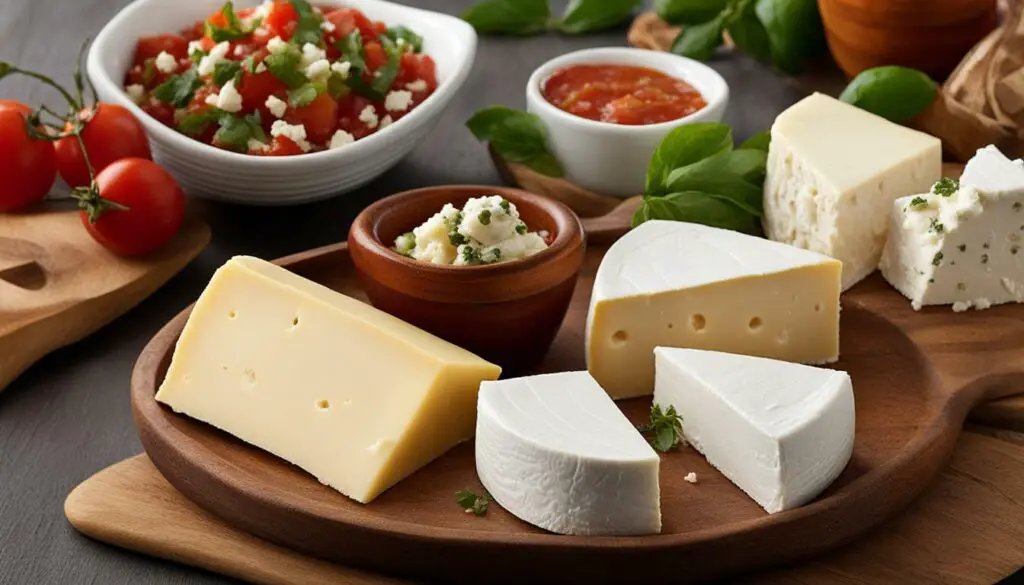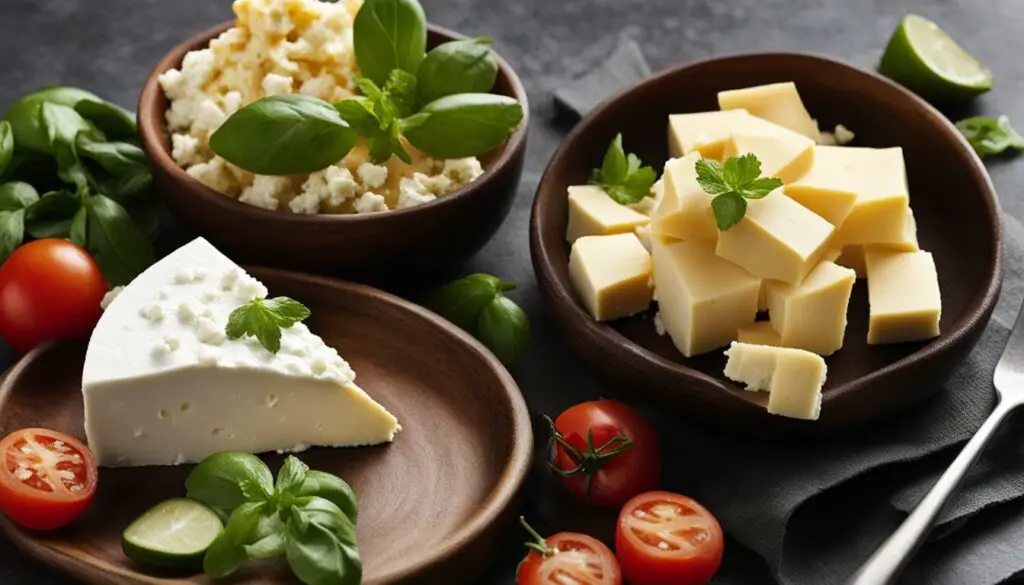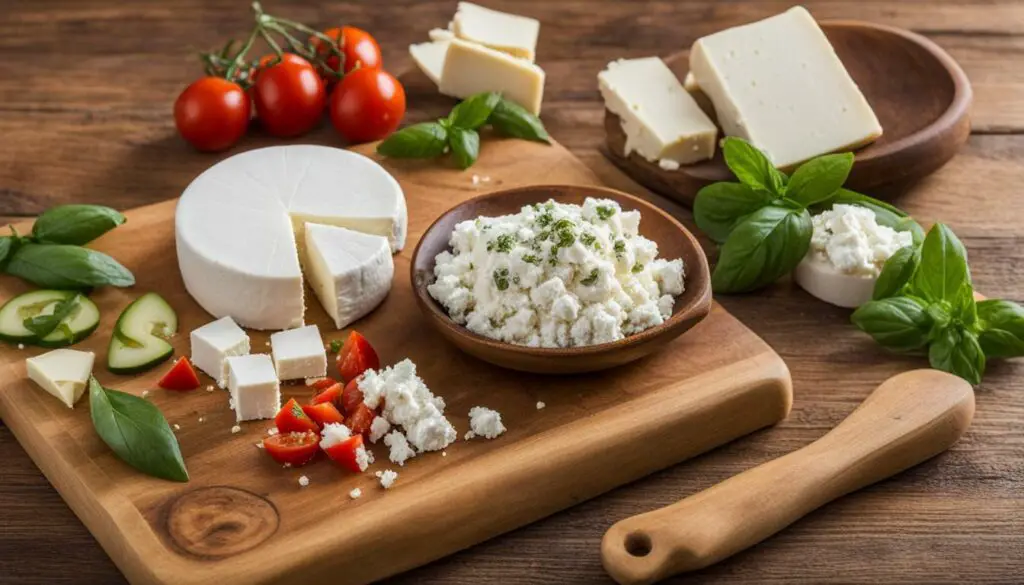Queso Fresco and feta cheese may look similar, but they have distinct differences that set them apart. Originating from Mexico, and Greece respectively, these cheeses offer unique tastes, textures, and flavors that can elevate your culinary creations. Join us as we delve into the comparison of queso fresco vs feta cheese, uncovering the cheesy differences that make them stand out.
Key Takeaways:
Contents
- 1 Origin and Ingredients
- 2 Taste and Flavor Profile of Queso Fresco vs Feta
- 3 Texture and Uses
- 4 Find out more about Queso Fresco
- 5 Can You Freeze Queso Fresco? Our Guide to Proper Storage
- 6 Is Queso Fresco Healthy? Unveiling the Truth | Our Discovery.
- 7 Oaxaca Cheese vs Queso Fresco: Unveiling the Delicious Mystery
- 8 Understanding Queso Fresco in English – A Cheesy Delight!
- 9 Discover How to Store Queso Fresco with Our Easy Tips!
- 10 Unraveling the Mystery: Does Queso Fresco Melt?
- 11 Queso Fresco vs Mozzarella: Exploring Cheesy Differences
- 12 Finding the Perfect Substitute for Queso Fresco – Your Guide
- 13 FAQ
- 13.1 Q: What is the difference between queso fresco and feta cheese?
- 13.2 Q: How are queso fresco and feta cheese used in cooking?
- 13.3 Q: Are queso fresco and feta cheese interchangeable in recipes?
- 13.4 Q: Are there other substitutes for queso fresco and feta cheese?
- 13.5 Q: What are the nutritional differences between queso fresco and feta cheese?
- Queso fresco and feta cheese have different origins and ingredients.
- Queso fresco has a mild and tangy flavor, while feta cheese is tangy, sharp, and salty.
- Queso fresco is crumbly, while feta cheese has a firm and crumbly texture.
- Queso fresco is commonly used in Mexican cuisine, while feta cheese is popular in Mediterranean-style dishes.
- Queso fresco is higher in sodium and saturated fat, while feta cheese is richer in vitamins and minerals.
Exploring the world of queso fresco and feta cheese will not only enhance your knowledge of these distinct cheeses but also inspire you to experiment with new flavors and textures in your cooking. So let’s embark on this cheesy journey together!
Origin and Ingredients
Queso fresco has its roots in Spain and Mexico, while feta cheese hails from Greece and is made primarily from sheep’s milk. Queso fresco, which translates to “fresh cheese,” is a soft and crumbly cheese that is traditionally made from cow’s milk. Feta cheese, on the other hand, is made from sheep’s milk, although it may sometimes contain a small amount of goat’s milk as well.
The production process for queso fresco involves curdling the milk with an acid such as vinegar or lemon juice, resulting in a fresh-tasting cheese with a mild and slightly tangy flavor. Feta cheese, on the other hand, is produced by allowing the milk to ferment and curdle naturally, which gives it a tangy, sharp, and salty flavor profile.
While the main ingredient in queso fresco is cow’s milk, feta cheese is primarily made from sheep’s milk, which gives it a unique flavor and texture. This difference in milk sources contributes to the distinct taste and characteristics of each cheese. Both queso fresco and feta cheese can be made using traditional methods or commercial processes, but their ingredients remain consistent with their cultural origins.
Queso fresco is a soft and crumbly cheese made from cow’s milk, while feta is made from sheep’s milk (sometimes with a small amount of goat’s milk).

Understanding the origin and ingredients of queso fresco and feta cheese is essential for appreciating their distinct flavors and textures. Whether you’re enjoying a creamy queso fresco topping on your favorite tacos or savoring the tangy saltiness of feta cheese in a Greek salad, these cheeses offer unique culinary experiences that reflect their cultural heritage.
Taste and Flavor Profile of Queso Fresco vs Feta
Queso fresco offers a mild and slightly tangy flavor, while feta cheese boasts a tangy, sharp, and salty taste. The taste of queso fresco is characterized by its subtle creaminess and delicate tang, making it a versatile cheese that can complement a variety of dishes. Its mild flavor allows other ingredients to shine while adding a subtle savory note. On the other hand, feta cheese is known for its bold and distinctive taste. Its tangy and salty flavor adds a punch to any dish it’s added to, creating a savory and robust taste experience.
When it comes to flavor, queso fresco and feta cheese offer unique profiles that cater to different culinary preferences. Queso fresco’s mild and slightly tangy flavor makes it a crowd-pleaser, appealing to those who prefer a more subtle and creamy taste. Feta cheese, with its sharp, tangy, and salty flavor, appeals to those who crave bold and intense flavors in their dishes. Whether you’re looking for a milder option or a flavor-packed addition, both queso fresco and feta cheese have distinct taste profiles to suit your culinary needs.
Taste Comparison in a Nutshell
- Queso fresco: Mild, slightly tangy, delicate creaminess
- Feta cheese: Tangy, sharp, and salty
As we explore the world of cheese, it’s fascinating to discover the nuances and variety in taste and flavor. Queso fresco and feta cheese offer distinct experiences, with queso fresco providing a milder and slightly tangy flavor, while feta cheese delivers a tangy, sharp, and salty taste. Whether you’re adding a touch of queso fresco to your favorite salads or indulging in the bold flavors of feta cheese in Mediterranean-inspired dishes, these cheeses offer a delightful range of taste options that are sure to please your palate.

Texture and Uses
Queso fresco has a soft and crumbly texture, making it ideal for use as a topping or garnish on dishes like tacos and salads. Its delicate texture adds a light and creamy touch to these dishes, enhancing the overall flavor profile. Whether you sprinkle it over warm grilled vegetables or use it to balance the richness of spicy salsa, queso fresco adds a delightful contrast to your favorite Mexican-inspired meals.
Feta cheese, on the other hand, boasts a firm and crumbly texture that perfectly complements Mediterranean-style cuisine. Its unique texture allows it to hold its shape when crumbled or sliced, making it an excellent addition to salads, sandwiches, and baked dishes. The combination of its crumbly texture with the tangy and salty flavor creates a harmonious balance of taste and texture. Feta cheese pairs exceptionally well with ingredients like olives, tomatoes, and cucumbers, bringing a burst of flavor and a satisfying bite to your Mediterranean-inspired creations.
Various Uses
- Queso fresco: Sprinkle it over grilled corn on the cob for a creamy and tangy twist.
- Feta cheese: Crumble it over a Greek salad to add a savory and tangy kick.
- Queso fresco: Use it as a filling in enchiladas or quesadillas for a melty and flavorful experience.
- Feta cheese: Incorporate it into baked dishes like spanakopita for a delightful burst of flavor.
- Queso fresco: Top off your favorite tacos with crumbled queso fresco for a creamy and refreshing finish.
- Feta cheese: Pair it with watermelon for a refreshing and savory summer salad combination.
Whether you’re craving the creamy and tangy notes of queso fresco or the firm and crumbly texture of feta cheese, these two cheeses are versatile in their unique ways. Experiment with different uses in your favorite recipes to discover your own perfect combination of taste and texture. The possibilities are endless!

When it comes to nutrition, queso fresco and feta cheese have their own unique profiles. Queso fresco tends to be higher in sodium and saturated fat compared to feta cheese. This means that if you are watching your sodium or saturated fat intake, you may want to consume feta cheese in moderation or opt for queso fresco in smaller quantities.
Feta cheese, on the other hand, offers higher levels of vitamins and minerals compared to queso fresco. It is a good source of calcium, which is essential for maintaining strong bones and teeth. Additionally, feta cheese provides significant amounts of vitamin B12, which is important for energy production and the functioning of the nervous system.
Both queso fresco and feta cheese can be enjoyed as part of a balanced diet, but it’s important to keep in mind their nutritional differences. If you’re looking to reduce your sodium and saturated fat intake, you may want to choose feta cheese. On the other hand, if you’re seeking a cheese that is higher in calcium and vitamin B12, queso fresco could be a better option for you.
Other Cheese Substitutes
If you’re unable to find queso fresco or feta cheese or simply want to try something different, there are several other cheese substitutes you can consider:
- Queso blanco: This white cheese, commonly used in Mexican cuisine, has a similar texture to queso fresco and can be used as a substitute in many recipes.
- Paneer: Hailing from India, paneer is a versatile cheese that is often used in savory dishes. Its mild flavor and firm texture make it a suitable substitute for feta cheese.
- Farmer’s cheese: This soft, mild cheese has a crumbly texture, making it a possible alternative to both queso fresco and feta cheese.
- Ricotta salata: With a slightly salty and crumbly texture, ricotta salata can be a good substitute for feta cheese in salads and pasta dishes.
- Halloumi: Originating from Cyprus, halloumi is a unique cheese that can be grilled or fried without melting. Its salty flavor and chewy texture make it a great substitute for feta cheese in Mediterranean-style dishes.
Remember, while these substitutes may offer similar textures and flavors, they may not be an exact match for queso fresco or feta cheese. However, they can still add a delightful twist to your recipes and open up new culinary possibilities.

If you’re unable to find queso fresco or feta cheese, alternatives such as queso blanco, paneer, farmer’s cheese, ricotta salata, or halloumi can be used as substitutes. These cheeses offer different flavors and textures, allowing you to experiment with new tastes in your dishes.
Queso blanco is a Mexican cheese that is similar to queso fresco. It has a mild and creamy flavor, making it a great replacement in recipes that call for queso fresco. Queso blanco is often used in Mexican cuisine, such as in enchiladas or quesadillas.
Paneer, a traditional Indian cheese, is another suitable substitute. It is a non-melting cheese with a firm texture and a mild taste. Paneer can be cubed and added to curries or grilled for a delicious vegetarian option.
Farmer’s cheese is a versatile substitute that can be used in a variety of dishes. It is similar to queso fresco but has a slightly tangier flavor. Farmer’s cheese works well in salads, sandwiches, or as a topping for baked potatoes.
Ricotta salata
“Ricotta salata is a firm, salted Italian cheese that can be grated or crumbled over salads, pasta, or roasted vegetables. Its saltiness adds a savory kick to your dishes.”
Halloumi, a popular cheese from Cyprus, is known for its unique characteristic of not melting when cooked. It has a salty and slightly tangy flavor, with a firm texture that becomes creamy when heated. Halloumi can be grilled or fried and is a delicious addition to salads or served as a main course.
With these cheese substitutes, you can still enjoy similar flavors and textures to queso fresco and feta cheese, even if you don’t have them on hand. Experiment with different recipes and explore the world of cheese to enhance your culinary explorations.

In conclusion, queso fresco and feta cheese may appear similar, but their taste, texture, flavor, and uses differ significantly. Queso fresco, originating from Spain and Mexico, is a soft and crumbly cheese made from cow’s milk. It has a mild and slightly tangy flavor that adds a creamy touch to dishes. On the other hand, feta cheese, hailing from Greece, is made from sheep’s milk (often with a small amount of goat’s milk) and has a tangy, sharp, and salty flavor that adds a distinct bite to Mediterranean-style cuisine.
When it comes to texture, queso fresco has a softer and crumblier consistency, while feta cheese has a firmer and crumbly texture. Queso fresco is commonly used as a topping or garnish for dishes like tacos, salads, and soups. Its creamy and delicate nature provides a refreshing contrast to the other ingredients. Feta cheese, on the other hand, shines in Mediterranean dishes and pairs well with ingredients like olives, tomatoes, and cucumbers. Its tangy and salty profile enhances the flavors of these dishes.
In terms of nutritional value, queso fresco tends to be higher in sodium and saturated fat, while feta cheese is richer in vitamins and minerals. Queso fresco offers a good source of protein, calcium, and phosphorus, while feta cheese provides essential nutrients like vitamin B12, calcium, and zinc. Both cheeses can be enjoyed in moderation as part of a balanced diet.
If you find yourself in need of a substitute for either queso fresco or feta cheese, there are a few options available. Queso blanco, paneer, farmer’s cheese, ricotta salata, and halloumi can all be used as alternatives. However, it’s important to note that while these substitutes may provide a similar texture or flavor profile, they may not offer the exact same taste experience. Experimenting with different options can help you find the perfect substitute for your recipe.
Find out more about Queso Fresco
FAQ
Q: What is the difference between queso fresco and feta cheese?
A: Queso fresco and feta cheese differ in their taste, texture, and origin. Queso fresco is a soft, crumbly cheese made from cow’s milk, while feta cheese is made from sheep’s milk (sometimes with a small amount of goat’s milk). Feta cheese is saltier than queso fresco, and it has a tangy, sharp, and salty flavor. Queso fresco, on the other hand, has a mild and slightly tangy flavor.
Q: How are queso fresco and feta cheese used in cooking?
A: Queso fresco is commonly used as a topping or garnish for dishes like tacos and salads. It adds a creamy and slightly tangy element to these dishes. Feta cheese, on the other hand, is popular in Mediterranean-style cuisine and pairs well with ingredients like olives, tomatoes, and cucumbers. It can be crumbled over salads, used in stuffed peppers, or incorporated into dips and spreads.
Q: Are queso fresco and feta cheese interchangeable in recipes?
A: While queso fresco and feta cheese are similar in appearance, they have distinct flavors and textures. This means that they may not be perfect substitutes for each other in all recipes. However, both cheeses can be used as substitutes in some dishes, depending on personal preference and the desired flavor profile.
Q: Are there other substitutes for queso fresco and feta cheese?
A: Yes, if you don’t have access to queso fresco or feta cheese, there are other cheese options that can be used as substitutes. Some alternatives include queso blanco, paneer, farmer’s cheese, ricotta salata, and halloumi. These cheeses have different flavors and textures, so it’s important to consider the specific recipe and desired outcome when choosing a substitute.
Q: What are the nutritional differences between queso fresco and feta cheese?
A: Queso fresco and feta cheese offer nutritional value, but they have different nutritional profiles. Queso fresco is higher in sodium and saturated fat, while feta cheese is higher in vitamins and minerals. It’s important to consume these cheeses in moderation and consider your dietary needs and preferences.
